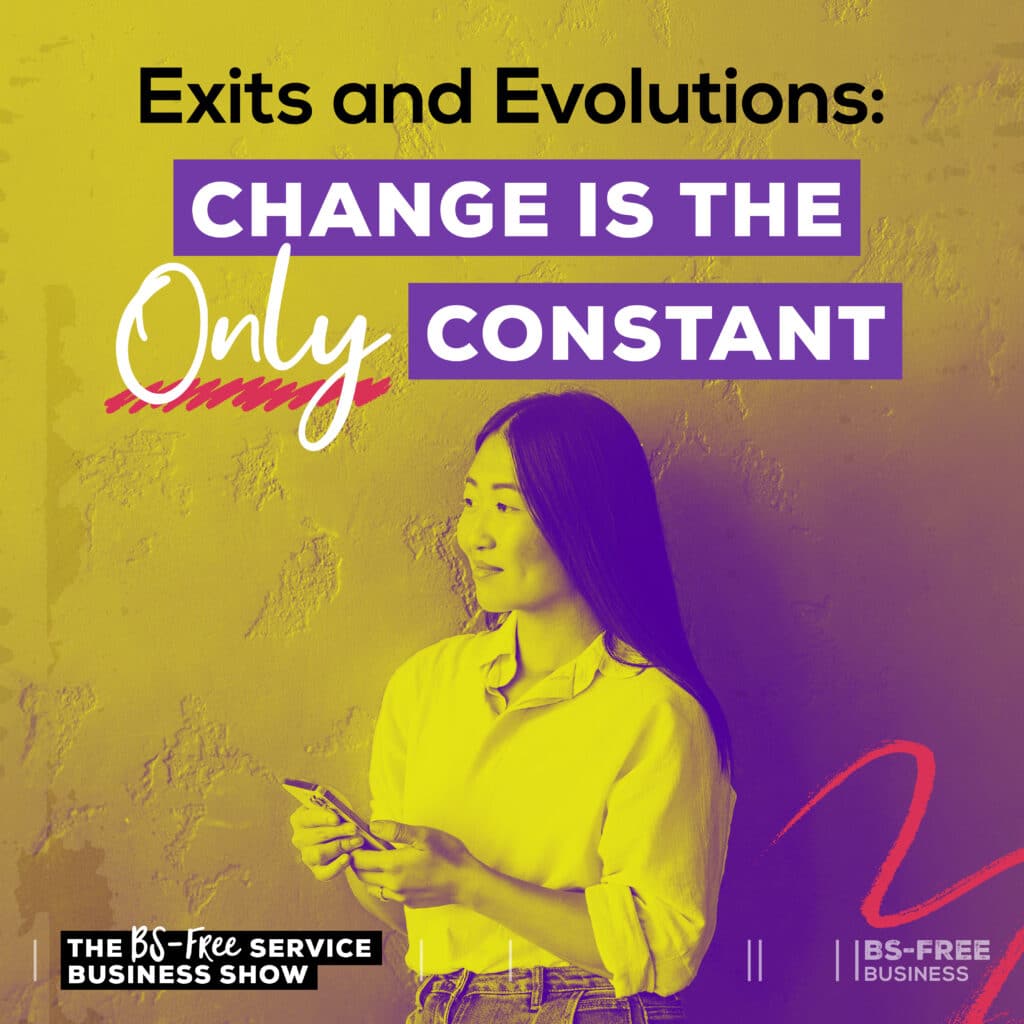
Search the site:
Exits and Evolutions: Change is the Only Constant
Running a business is like riding a rollercoaster—constantly navigating twists, turns, and unexpected loops. Sometimes, it’s thrilling, and other times, you feel sick because we’re constantly adapting and dealing with whatever comes our way.
In this episode, we’re wrapping up our exits and evolutions series, looking at the theme that change is the only constant in business. From navigating the complexities of change to unravelling the psychology behind our resistance to it, by the end of this episode, I guarantee you’ll look at how, when and why you make decisions for your business a little differently.
To wrap up this series, I wanted to explore the reality that change will always be constant in our businesses. But how do you make those changes? When should you consider making changes? Or when are you better off sticking with what you’re already doing?
Before exploring those questions in more detail, let’s chat about change management, which exists because change of any kind can be difficult.
If you’re unfamiliar with change management, MIT Human Resources defines it as a “set of ideas, strategies, and skills that can be applied to engage change effectively.” It’s a proactive process that involves planning for change, implementing it, and continuously supporting it.
Change management can be helpful for solo business owners or those with a small team as it encourages us to think proactively about the impact of change. Many times, it’s easy to decide on a change you need to make, but you may fail to account for everything required to make it happen.
There are many different models for change management, but one I particularly like is the idea of the 4Cs. What the Cs stand for will vary depending on who uses them, but for our purposes, they give us a simple approach to considering change within our business.
GRC Outlook outlines the 4Cs as clarity, communication, commitment, and consistency. Thinking about changes to your business gives you an outline for how to work through what needs to happen.
Let’s say you’re changing your pricing and need to roll this out to clients. Using the 4Cs, you can make the process of that change tangible:
- Clarity: Why are you making this change? How does it impact clients?
- Communication: What do people need to know? What questions might they have? What’s the timeline?
- Commitment: Are you ready to make this change? What will help you see it through?
- Consistency: How will you apply this change to your existing and future clients? How will you ensure that you don’t backtrack or make exceptions?
When making decisions about change, I find it helpful to consider these steps. I’ll often get to the point where I need to be committed or communicate it and opt not to make that choice. What may make sense in my head doesn’t always do once I start laying out everything involved.
Change management isn’t just for huge changes. Harvard Business School lays out two types of change: adaptive and transformational. Adaptive changes are “small, gradual, iterative changes” while transformational ones are larger in “scale and scope, and often signify a dramatic, and occasionally sudden, departure from the status quo.
Considering my conversations in this series, Zoe and Andréa’s changes have been adaptive. Meanwhile, what Jules and AdeOla shared with us are bigger, transformational changes.
Why Can Change Be So Hard?
We all know how hard change can be at times. If you’ve ever tried to form a new habit, you know exactly what I’m talking about.
I’m not an expert on this topic, but change is often seen as a threat to our safety and control. We like what’s familiar and comfortable; making changes can cause stress and anxiety.
So while exits and evolutions are natural for us in our business, and you may even be excited about making them, the primal part of our brain can be working overtime.
This is exactly why the discipline of change management exists. If you’re feeling some kind of way about a change as a team of one, imagine how challenging it can be to make transformational changes in an organization with thousands of people.
When making business decisions that involve change, you need to be ready for your brain to start second-guessing everything. This doesn’t automatically mean it’s a bad idea, this is an entirely normal reaction.
The key is knowing when you feel uncertain or resistant to change and when your gut tells you you made the wrong call. This is also why I’m a big fan of making changes methodically and not trying to rush everything. After working through the 4Cs above, you’ll have more confidence in your choices and be able to see them through.
With that in mind, when is the right time to make a change, and when should you proceed cautiously?
Surefire Signs That It’s Time for a Change
I’m fairly decisive and have the type of personality where I always make small (and big) changes. A running joke between my partner and I is that we can decide on a major life change in minutes (this was the case with moving five years ago), but don’t ask us to decide what to have for dinner. If there’s no meal plan, it’s a mess!
With my default programming, I’ve had to learn to move a little slower in my business. As much as I run on gut feeling, I value slowing down and thinking through the changes I want.
I share this because the reality is that some exits and evolutions should be easier yeses than others. Sometimes you’ll have surefire signs that you need to start thinking about how you’ll change.
Sometimes you need to proactively address tech changes, new market trends, or customer expectations. Other times, you’ll need to react to changing personal needs or emerging economic conditions.
Those are just a few examples of reasons to change that I shared in the episode that kicked off this series. You should also watch a few others related to how you feel in your business.
For example, if you’re constantly resentful of your clients, that’s a sign you need to make some changes to create better boundaries. Or maybe you need to position yourself as more of an expert by selling strategy so you command their respect.
Trust me when I say that you need to feel good about your client relationships if you want to offer services in your business. So if you’re sick of their BS and completely worn out, it’s time to do something about it.
Another area that needs constant evolution is your schedule. What works for you with your calendar or time management may not work for another.
I recently had to reboot my scheduling and went back to time blocking. I can guarantee I’ll change that up again soon enough, but I was willing to make that change to feel a sense of calm. If there’s one thing I cannot stand with my work is feeling overwhelmed and/or chaotic.
In the interview with Jules Taggart, she shared what I’d consider a hell-yes example of when something needs to evolve in your business when the numbers just aren’t working and it’s impacting your mental health. Zoe Linda also shared how she’s always changing to meet her needs as a disabled, neurodivergent entrepreneur.
Valid Reasons For Change (But Proceed with Caution)
This next section will make some of you uncomfortable as I talk about real and valid reasons for change, but they come with much nuance.
I constantly hear from my clients that they’re bored. I get it—I do—but hear me out. Being bored can be a positive sign for your business, meaning you’ve probably built something simple and sustainable.
Which is the point if you ask me! Did you start building a business to hustle and chase a dream endlessly? It’s okay to be bored and enjoy what you’ve built.
Remember, we’ve been indoctrinated into hustle culture and the idea that owning a business means always being in growth mode.
If you’re truly bored, I highly recommend getting some hobbies and enjoying your life. Work is just one part of who you are as a human.
I relish being bored in my business, but there’s a distinct difference between being bored and reaching a point where there’s simply no more challenge left. I’m still challenged, just not running around chaotically putting out fires like I used to.
So what if you need a new challenge like AdeOla Fadumiye shared in her interview? That’s a legitimate reason to make changes, which will happen at certain points in your business journey.
Or what if your market is shifting, and you need to re-think what you’re doing or how you’re doing it? That’s where Andréa Jones found herself, leading her to move from the role of social media management to mindful marketing.
In each case, I’d proceed cautiously and not make a reactive decision. These are important potential evolutions that require time to assess the potential change’s clarity, communication, commitment, and consistency.
While you can pivot quickly, you don’t have to. You can take your time so you move deliberately and thoughtfully.
A great example is Andréa because, as someone in social media management, she could easily have fallen into the trap of chasing trends and wasting time, energy, and resources.
There have been times I’ve been tempted to change my work to chase trends, and in hindsight, I’m so glad I didn’t. Those trends have come and gone so quickly, and people building their businesses around them have had to reinvent themselves with each successive trend.
On the other hand, I’ve been doing the same things for nearly a decade with BS-Free Business.
Not-So-Great Reasons for Evolutions or Exits
Finally, I want to discuss some less-than-hot reasons for changing your business.
As much as change will always be part of your business, it’s far too easy to fall into the trap of relying on that tinkering to create excitement. This can be a slippery slope as you can become overly reliant on your business to supply dopamine hits so you feel happy, motivated, or satisfied.
This can lead to overwork and burnout, straining relationships and your health. Making changes because you’re fixated on your work and looking for rewards is a sign that it’s time to reassess your relationship with work and seek fulfillment in healthier ways.
Speaking of the emotional side, if you’ve ever had an “I’m going to burn it down” moment in your business, consider this your official reminder not to make any changes when you feel this way. These moments can sometimes be a breaking point that leads you to a positive, much-needed change, but decisions made in the heat of the moment can quickly lead to regret.
The realities of comparison and peer pressure align closely with the desire to chase the trends that I touched on above. These are TERRIBLE reasons to drive you to evolve, as they come from outside your circle of influence and usually from a place where you’re not feeling good.
There’s a major difference between recognizing that your work needs to adapt and obsessing over what your competitors are doing or feeling like you have to do something because all your business friends are.
Finally, I want to mention that owning a business can be challenging, and it’s often not like the shiny image sold to us. You need to acknowledge that image is NOT reality, it’s a sham, and not fall for the BS dream.
Too many talented and amazing business owners completely tank their businesses because they make so many changes to chase a dream that’s fake AF.
I don’t want that for you, so at the risk of being a #dreamkiller, dream big for your business, but with a hefty dose of reality. Making changes because some celebrity entrepreneur is teaching it in their outdated course isn’t the way.
Navigating Change: Embracing the Inevitable Shifts of Business
Through this series, I hope you’ve recognized the fundamental truth that change is the only constant in business and feel a little less alone in the exits and evolutions you need to make in the coming months and years.
Whether you need to make small or big transformational changes, carefully considering if it’s the right move can make all the difference.
Links for this Episode:
- MIT – The Basics of Managing Change
- The 4 Cs of Leading Through Change
- 5 Critical Steps in the Change Management Process
- Why People Resist Change and What Leaders Can Do to Mitigate This
- Exits and Evolutions: Navigating Change In Your Service Business
- Brave Boundaries Free Workshop
- Sell the Strategy Intensive
- From Solo to Agency and Back Again with Jules Taggart
- Mindful Marketing: Andréa Jones Shares Her Social Media Evolution
- Building a Business by Blending Products and Services with Zoe Linda
- The Art of Reinvention with AdeOla Fadumiye
- How to Spot a Celebrity Entrepreneur


I’m Maggie Patterson (she/her), and services businesses are my business.
I have 20+ years of experience with client services, am a consultant for agency owners, creatives, and consultants, and vocal advocate for humane business practices rooted in empathy, respect, and trust.
Read or Listen to the Latest
Help Not Hype

Tired of the same old BS business advice?
I got you with weekly emails packed full of proven strategy that makes a real difference in your service business.









